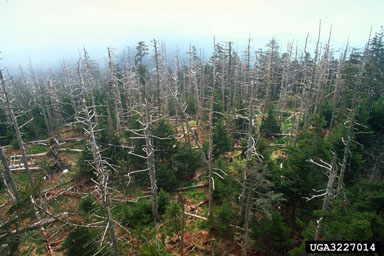 Tree Extinction Tree Extinction
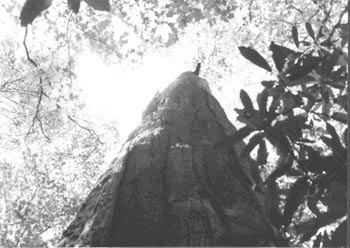 The American Chestnut (Castanea
dentata) The American Chestnut (Castanea
dentata)
This is a story that I transcribed from the February 4, 2002 edition of the
Enterprise Mountaineer. I do not yet have permission to republish this story,
but I decided to go ahead and add it to my site in the meantime. This article
gives you an idea of what was lost to our forefathers when the American
chestnut blight, carried here when people brought Chinese chestnuts to North
America at the turn of the 20th Century, caused one our our greatest trees to
go extinct. It also tells of the hope that we may one day see the tree, or at
least a genetically altered hybrid, once again in these forests.
The Return
Of The Chestnut by BECKY JOHNSON, Staff writer, The Enterprise Mountaineer
You can still see the remnants of the American Chestnut tree on the Ranch.
Because of the rot resistance of the wood, if you are taking a hike and see a
very large, weathered and gray stump, cut off about 2 or 3 feet above the
ground, it's actually the 70 year old remains of an extinct American chestnut
tree. All the other trees stumps from that era have long since rotted away.
Also, not mentioned in the above article was the fact that when the American
chestnut tree was wiped out, it took the number one food supply for almost all
the wildlife along with it. Needless to say they have not recovered.
Read more about the American Chestnut what happened and it's possible future at
the American Chestnut Foundation website.
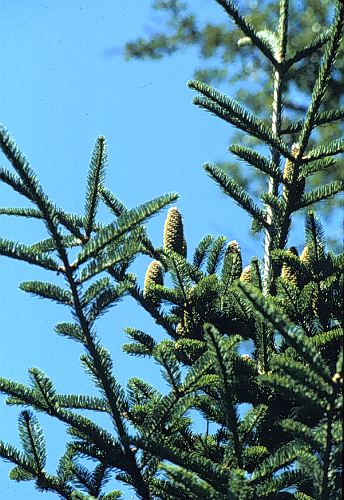 The Southern Balsam Fir or Fraser Fir
(Abies fraseri) The Southern Balsam Fir or Fraser Fir
(Abies fraseri)
One thing first, as you can see from it's Latin name Abies fraseri, Fraser
Fir is it's proper name. However, every local you meet will call the tree a
Balsam. Even the botanist disagree with our Fir being given a different status
from Abies balsamea (read the Taxonomic notes from this
page.).
So, true to my native WNC nature I always call the tree a Balsam. Heck, there
is even a community west of Waynesville called Balsam, named for the giant
stands of the tree that stood on the mountain tops before they where logged.
The southern Balsam is the only Fir native to the southern Appalachians. It
is a remnant of the great Fir forest that covered these mountains during the
last great Ice Age. As the Glaciers, which never reached the southern
Appalachians, retreated the Fir forest moved north with them to Canada, leaving
"islands" of the Firs on the highest southern peaks where the climate
is the same as Canada.

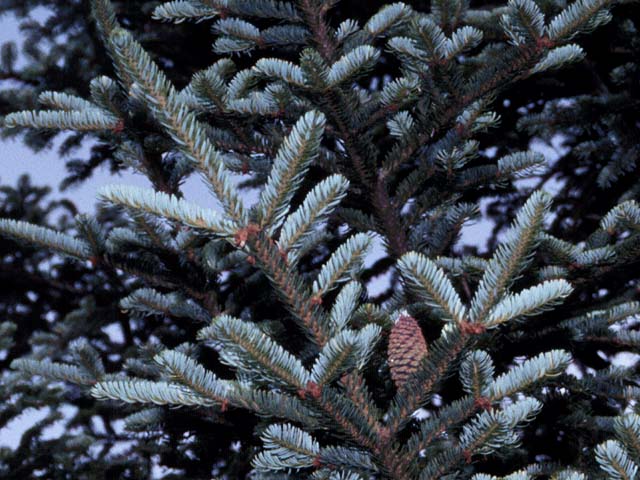 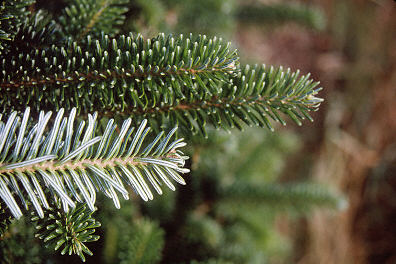
But, alas, we may live to see the end. The native, mature Balsam has been
all but wiped out by the
Balsam
woolly aphid (Adelges piceae) and acid rain. The Balsam woolly aphid
is a nasty little sap-sucker, literally. It bites though the trunk bark until
it can get to the tree sap. The chemical make-up of the saliva of the aphid
causes the tree to create a chemical that hardens the area around the bite.
As more and more aphids bite the tree the hardening effect eventually reaches
the point where the tree can no longer draw water up through the trunk, and the
tree dies from that point up. As time progresses the whole tree dies. All the
great stands of the Fir that once stretched along the Blue Ridge Parkway, died
in the late 70s and early 80s. Their children are growing up underneath the
still standing dead parents, but they too will succumb to the aphid.
Some trees
will survive however, North Carolina is the largest Fraser Fir Christmas tree
producer in the country. These farms will use chemical pesticides to protect
their farms. I'm very familiar with this industry since my Mom was born and
raised in the Christmas
Tree capital, Avery County.
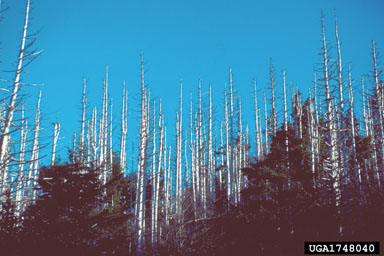 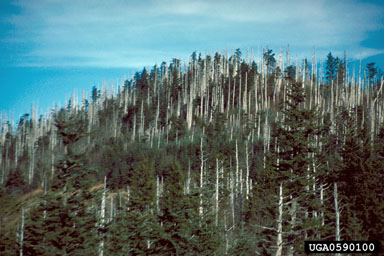  As many of you may know Balsams are my favorite tree. Partly
because they are rare and grow only in the highest and most beautiful places we
have. If you are out hiking and see a native Balsam you will most certainly be
in one of the most beautiful places on Earth.
Another reason I like the tree is
because I want to save it. However, the Ranch ,at 4100 feet elevation, is at the
extreme lower limit for growing the tree, but I am going to try. For those of
you have come to the Ranch, you may not have realized that we have a small
stand of Balsam planted by Dan and John, standing above the pond at the
intersection of Juniper road and Beechwood road.
While writing this article I did a search on http://www.google.com for
"Adelges piceae", and found this
site.
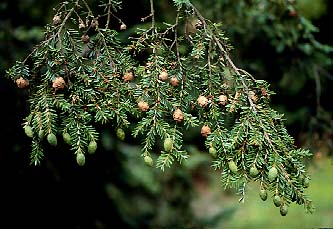 The Eastern Hemlock(Tsuga canadensis)
and Carolina Hemlock (Tsuga caroliniana) The Eastern Hemlock(Tsuga canadensis)
and Carolina Hemlock (Tsuga caroliniana)
My second most favorite tree is the Hemlock, especially the rare Carolina
Hemlock. Their limbs come out of the trunk hang downwards somewhat and droop at
the end. And unlike most pines, the Hemlocks needles are soft and subtle. The
over all effect is that the Eastern and Carolina Hemlock are grand and graceful
trees. The Eastern Hemlock is the most shade tolerant of the eastern pines.
It's found mostly on north facing slopes, older forests, and rocky stream
valleys, It grows slowly, but can grow up through almost any forest type when
healthy. Hemlocks often grow in pure stands, and healthy hemlock stands are
almost magical with their dark shade, their straight, tall trunks, and their
clear forest floor, as very few plants can grow with so little light. Hemlock
needles are short, usually less than an inch long, and they grow in two rows on
each side of the branch. The bark is a dark silver on young trees and branches,
turning gray and eventually reddish with age. The cones are very small.
  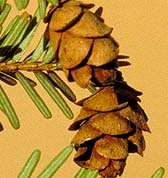 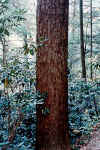 However, it looks like the
Hemlock too will suffer the fate of my other favorite trees. Death caused by us
transporting other insects and diseases from around the world to here. The
Balsam wooly aphid (Adelges piceae) that is exterminating the Fraser Fir
has a sap-sucking Japanese cousin , of course named after the tree it kills,
the Hemlock wooly aphid (Adelges tsugae) that is on its way here. Last
summer infected trees where spotted in the southern part of the Smoky Mountain
National Park and in the Murphy and Andrews area. I found this
link
to a map showing the infected and newly infected counties in 2001. It looks
like Haywood county is being surrounded. There are other
links from this site that explain more. The USGS is working with the National
Park Service to try and determine the factors that cause the spread of the
aphid. After reading several of these articles, it appears that some stands of
Hemlock manage to not be totally wiped out, but they are not sure of the
reasons. It appears altitude plays the biggest role in this. Let's hope so! The
Hemlock Wooly
Adelgid Web Site has a lot of links that give a lot of information about
what is going on with the battle. I found a really good
page
that describes the search for biological controls. This site will require you
to have or install the Acrobat plug-in if you don't already have it.
One of the reasons I built my house where I did was because of the
surrounding Hemlocks. They give color, protection, and grace to the woods
around the house year round. I would have to move if anything happened to my
them. This place would be haunted by their memory.
 Black Locust (Robinia pseudoacacia) Black Locust (Robinia pseudoacacia)
I have very mixed feelings about this tree, thought it's not
the trees fault. In the spring, the sweet smell of the multitudes of Locust
blooms is the smell of ambrosia, heaven on Earth. Because of the smell of
Locust or Black and Yellow Locust are often referred to as Honey Locust, and
indeed the bees do make honey from these blooms. However, the Honey Locust is
actually the name of another species of tree, Gleditsia tricanthos. Because of
its rot resistance, the Locust took over the role of the American chestnut for
many things like fence posts and rails. They have a very, very dense wood which
is very heavy, but makes excellent firewood. The wood will burn at a slow pace
for a long time.
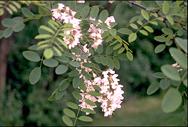 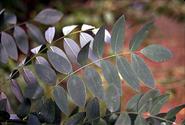
So why
might you ask you I not like this tree? I'm not sure how the tree got the name
"Black" Locust, but in the winter, their dark, dark, rough bark looks
black. And their twisted shapes, make the areas they grow look like one of the
most depressing areas I know. Looking dead and haunted when there are no leaves
on the trees. On top of this, they have very nasty thorns that always tend to
whack you or scrape you when you go near one, especially the saplings. So I
guess this is why I dislike them so.
 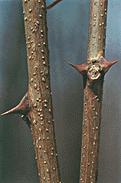 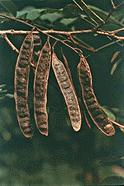 The Locust is a reforestation tree, or as I refer to
them a "weed tree" or "scab tree". You may hear locals call
an area "scab woods", referring to the fact that the forest is trying
to heal itself. In fact many, many places aroun Haywood county and just about
every where else have "scab" woods. I see "scab" woods alot
along roads, as the locust and briars take back over the road banks. The
saplings that I'm constantly have to fight back from my pastures will grow from
nothing to 6-8 feet in one summer. So when you see a Locust you can be very
certain that the area was pasture, not that long ago. After the the Locust
establish a cover, the other trees move in and then crowd out the Locust.
However, this tree may be one on its way to extinction here too. About 12 years
ago I started noticing that all the leaves on the Locusts in Tennessee and the
piedmont of North Carolina where turning brown about halfway through the
summer. By late summer they where nothing but leaf skeletons. Over the years
this plague has moved higher and higher up into the mountains. It finally
covered Haywood county about 4 years ago. This plague is the
Locust Leaf
Miner(Odonatata dorsalis). The leaf miner is a beetle about 1/4
inches long that along each stage of it's development from larvae to adult eats
different sections of the leaf. In the end nothing is left. Apparently, since
the leaf destruction starts slowly, the trees are able to get some energy from
their leaves because the tress don't immediately die. But it does weaken them
and if any other pests invade, the tree probably won't survive. So far, the
leaf miner has not made it all the way up to the Ranch. I suspect that our
colder climate has kept the beetles at bay, but with the winters getting as
warm as they are, it is probably only a matter of time.
Back to Our Forest
|

 Tree Extinction
Tree Extinction The American Chestnut (Castanea
dentata)
The American Chestnut (Castanea
dentata) The Southern Balsam Fir or Fraser Fir
(Abies fraseri)
The Southern Balsam Fir or Fraser Fir
(Abies fraseri)








